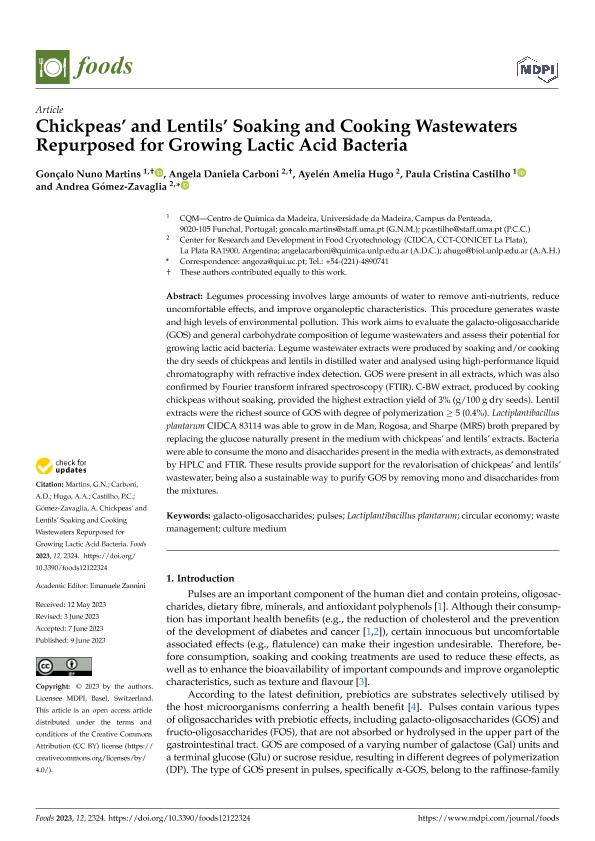Artículo
Chickpeas’ and Lentils’ Soaking and Cooking Wastewaters Repurposed for Growing Lactic Acid Bacteria
Martins, Gonçalo Nuno; Carboni, Angela Daniela ; Hugo, Ayelen Amelia
; Hugo, Ayelen Amelia ; Castilho, Paula Cristina; Gomez Zavaglia, Andrea
; Castilho, Paula Cristina; Gomez Zavaglia, Andrea
 ; Hugo, Ayelen Amelia
; Hugo, Ayelen Amelia ; Castilho, Paula Cristina; Gomez Zavaglia, Andrea
; Castilho, Paula Cristina; Gomez Zavaglia, Andrea
Fecha de publicación:
06/2023
Editorial:
Multidisciplinary Digital Publishing Institute
Revista:
Foods
e-ISSN:
2304-8158
Idioma:
Inglés
Tipo de recurso:
Artículo publicado
Clasificación temática:
Resumen
Legumes processing involves large amounts of water to remove anti-nutrients, reduce uncomfortable effects, and improve organoleptic characteristics. This procedure generates waste and high levels of environmental pollution. This work aims to evaluate the galacto-oligosaccharide (GOS) and general carbohydrate composition of legume wastewaters and assess their potential for growing lactic acid bacteria. Legume wastewater extracts were produced by soaking and/or cooking the dry seeds of chickpeas and lentils in distilled water and analysed using high-performance liquid chromatography with refractive index detection. GOS were present in all extracts, which was also confirmed by Fourier transform infrared spectroscopy (FTIR). C-BW extract, produced by cooking chickpeas without soaking, provided the highest extraction yield of 3% (g/100 g dry seeds). Lentil extracts were the richest source of GOS with degree of polymerization ≥ 5 (0.4%). Lactiplantibacillus plantarum CIDCA 83114 was able to grow in de Man, Rogosa, and Sharpe (MRS) broth prepared by replacing the glucose naturally present in the medium with chickpeas’ and lentils’ extracts. Bacteria were able to consume the mono and disaccharides present in the media with extracts, as demonstrated by HPLC and FTIR. These results provide support for the revalorisation of chickpeas’ and lentils’ wastewater, being also a sustainable way to purify GOS by removing mono and disaccharides from the mixtures.
Archivos asociados
Licencia
Identificadores
Colecciones
Articulos(CIDCA)
Articulos de CENTRO DE INV EN CRIOTECNOLOGIA DE ALIMENTOS (I)
Articulos de CENTRO DE INV EN CRIOTECNOLOGIA DE ALIMENTOS (I)
Citación
Martins, Gonçalo Nuno; Carboni, Angela Daniela; Hugo, Ayelen Amelia; Castilho, Paula Cristina; Gomez Zavaglia, Andrea; Chickpeas’ and Lentils’ Soaking and Cooking Wastewaters Repurposed for Growing Lactic Acid Bacteria; Multidisciplinary Digital Publishing Institute; Foods; 12; 12; 6-2023; 1-14
Compartir
Altmétricas



